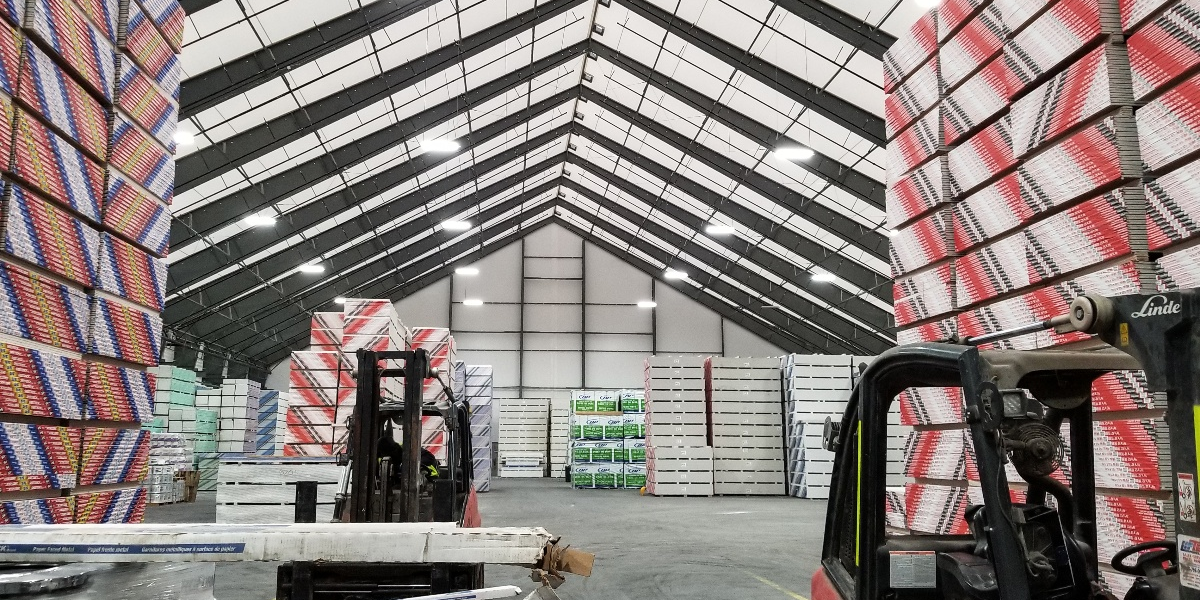Why Fabric Structures Over Pre Engineered Buildings?

Pre-engineered metal buildings (PEMB) are growing in popularity because of their benefits compared to traditional construction: reduced construction time, customizability, and energy efficiency.
PEMB does retain these advantages against traditional steel building construction. However, fabric structures take these advantages to another level – where PEMB can’t compete.
Engineered, Not Pre-Engineered
Pre-engineered metal buildings are engineered once for mass production – all customers receive a building with identical engineering, with some basic adjustments for factors like environmental loads. The customer then picks from a selection of stock options to “customize” the building – for example, adding a second door or a few additional feet to the length.
In contrast, Legacy custom engineers each fabric structure. This allows the customer to choose any option or combination of options to personalize the building around project specs and business needs. Engineering options not available in pre-engineered buildings include a conveyor slightly to one side of center, multiple cargo doors along each sidewall, or even completely open sidewalls. The building engineer will accommodate these items and local building codes and regulations into the finished building design.
Legacy buildings and PEMB both use rigid steel frames. Learn more.
Engineered buildings are especially advantageous in areas with harsh weather. Engineering accommodates multiple dead loads from heavy snow, high winds, and ancillary – ensuring many years of safe, effective operation.
Energy Efficiency
Pre-engineered metal buildings are constructed with steel sheeting. While steel is a long-lasting building material, it has several energy-efficiency drawbacks, including blocking all-natural light and increasing thermal bridging.
Fabric structures have none of these concerns. Depending on the type and weight of fabric chosen, the material has up to 12% translucency. This influx of natural light has benefits beyond creating a pleasant interior atmosphere. Lighting costs are reduced or eliminated, along with lost time due to dead lights and replacement.
Read a complete building performance report from TWS Engineering.
Unlike steel, fabric is a non-conductive, climate-responsive building material. Rather than magnifying the heat or cold outside the building, the fabric better retains the inside temperature. The climate-responsive building material prevents temperature swings inside the building, making climate control easier and less expensive, and reducing condensation and moisture build-up.
Even Faster Construction
One of the advantages of PEMB is expedited construction – rather than starting the building design from scratch, the owner selects from the builder’s stock. Then the building is installed by the builder or a contractor using pre-drilled holes and simple assembly plans.
Fabric structures compound this speed of construction. Fabric cladding is applied about three times faster than steel sheeting – for faster completion, faster building occupancy, and lower construction time and related costs.
When rapid construction is the primary concern, many building owners assume they have to choose from stock building designs and materials available in inventory. However, there is a way to reduce construction time while having complete build-to-suit customization: Design-build construction. With design-build construction, the building owner partners with one entity to design and construct a custom building. This allows the building owner to eliminate the weeks spent soliciting and comparing bids and the time lost due to miscommunication and misunderstandings during construction.
Combining design-build construction plus fabric cladding gives building owners the option of a custom building constructed in weeks, not months.
Cost-Effective to Repair or Replace
All buildings, especially in industrial applications, are subject to regular wear and tear – and require occasional repair and replacement.
Over time, steel will corrode. In corrosive environments – such as salt storage, fertilizer storage, and marine applications – corrosion will happen in just a few years. Once corrosion begins, it is nearly impossible to stop.
Corrosion is ugly and eventually dangerous as the building frame and cladding is eaten away. Fabric, made of sturdy PE or PVC material, is inert to the effects of corrosion – even in the presence of corrosives, chemicals, heat, or moisture.
Need a fabric structure repair?
Replacing steel sheeting is an expensive and time-consuming proposition. When the roof requires repair (such as after a hail storm), small repairs require using fasteners (which can introduce leaky holes). Repairing a fabric structure is a simple matter of welding a new patch of fabric over the damaged area. It is a process that can be completed for just a few dollars per square foot.
The cost difference between steel and fabric buildings is most striking in leased situations. Fabric cladding may be detached from the frame, rolled up, and trucked to the new location with no loss of quality. This allows the building to be relocated – or reconfigured or expanded – multiple times without compromising the structural integrity.
Consumers today have unlimited options when it comes to building design and construction. Rather than dealing with the constraints of traditional construction or pre-engineered solutions, fabric structures allow the building owner to capitalize on the benefits of customizability, reduced construction time, and energy efficiency.
A personal consultation is the best way to learn the advantages of fabric structures. Contact us to request a one-on-one meeting with an experienced consultant.
